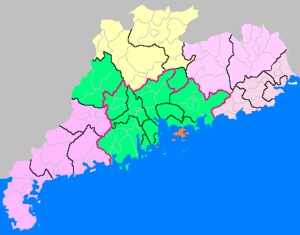Hengqin
| Hengqin 横琴新区 | |
|---|---|
| New Area | |
|
Hengqin | |
| Country | China |
| Region | Zhuhai / Macau (leased lands) |
| Area | |
| • Total | 106.46 km2 (41.10 sq mi) |
| Population | |
| • Total | 6,300 |
| • Density | 59/km2 (150/sq mi) |
| Time zone | China Standard / Macau Standard (UTC+8) |
| Website | http://www.hengqin.gov.cn/ |
| Hengqin | |||||||||||||
| Chinese name | |||||||||||||
|---|---|---|---|---|---|---|---|---|---|---|---|---|---|
| Simplified Chinese | 横琴新区 | ||||||||||||
| Traditional Chinese | 橫琴新區 | ||||||||||||
| Literal meaning | Horizontal Qin New Area | ||||||||||||
| |||||||||||||
| Portuguese name | |||||||||||||
| Portuguese | Nova Área de Hengqin | ||||||||||||
Hengqin is an island in Zhuhai, a prefecture-level city and Special Economic Zone in the Guangdong province of the People's Republic of China. It has a population of about 3,000. Parts of Hengqin are leased to Macau by the State Council of the People's Republic of China in 2009.
The whole island is designated a special economic district, as Hengqin New Area, similar to Binhai New Area in Tianjin and Pudong New Area in Shanghai.
Geography
Hengqin Island is adjacent to Taipa and Coloane of Macau with the Shisanmen Waterway in between, and is connected to Macau's Cotai via the Lotus Bridge. The island is the largest among the 146 islands of Zhuhai, being roughly three times the size of Macau. It has broad bays, sandy beaches, strangely shaped jagged rocks, beautiful scenery, fresh air, and natural vegetation cover.
Hengqin was formerly made up of two islands, Xiaohengqin (Portuguese: Dom João) and Dahengqin (Portuguese: Montanha), which were recently connected as a result of land reclamation. The reclaimed island is 96 km2 (37 sq mi) large.
History
Portugal claimed both Xiao Hengqin and Da Hengqin, along with the larger former island of Wanzai (Portuguese: Lapa) — now a peninsula — to their north, as part of the Província da Macau, because "Portuguese schools are established there".[1] In 1896, Portuguese determined to occupy the two islands of Hengqin, but did not succeed in doing so. Portugal briefly occupied them before World War II.[2]
Since the land reclamation and development, there has been a growing opinion in Macau that the island should be leased to Macau, which has very limited land and little room for further development. By 1 September 2005, plans were revealed that the government of Guangdong will allow tax exemptions and adopt flexible immigration control in Hengqin to promote investment from Hong Kong and Macau.
In late 2005, Las Vegas Sands openly discussed its multibillion-dollar plan to develop parts of Hengqin Island into a convention and resort destination. The project was to include four million sq ft of convention space, hotels, retail, vacation homes, and golf, tennis and yachting amenities.[3][4]
On 27 June 2009 the government of Macau officially announced that the University of Macau would build its new campus on 1 km2 of the island, in a stretch directly facing the Cotai area, south of the current border post. This would be the first of other possible projects. Construction of the campus would take three years[5] and would include an underwater tunnel. Macau law would apply in the university campus and it would not be necessary to pass a formal border post.[6] The Macau Special Administrative Region will pay an amount of rent - which has not yet been set - for the use of the land.
Subdistricts of Hengqin New Area

- Northwestern Zone - reserved for environmentally friendly development projects
- Northern Zone - A Bridge and main entrance between Central Zhuhai and Hengqin New Area
- Northeastern Exhibition Zone - development of an exhibition center and hotels
- Central Channel - develop as a leisure and recreational theme park
- Eastern Residential and Commercial Zone - codevelopment of PRC and Macau projects such as University of Macau's new campus
- Southern Tourist Zone - A future tourism attraction which is further divided into seven sub-zones
- Theme Park Area
- Seaside Hotel Area
- Natural Tourist Area
- Scenic Area
- Water Activities Area
- Seaside Holiday Resort Area
- Golf Course Holiday Resort Area
On 29 November 2010, the main body of the Chime-Long International Ocean Resort (with an initial investment of 10 billion yuan) kicked off the construction on Hengqin Island and was originally expected to become operational in 2013.
The Chime-Long Ocean Kingdom, consisting of entertainment facilities, amusement rides, performances, high-tech experiences and animal watching as well as the dolphin-themed hotel with 1,888 guest rooms was opened in 2014.
See also
References
- ↑
- ↑ http://www.worldstatesmen.org/China_Foreign_colonies.html#Macau
- ↑ Las Vegas Sands press release, 1/11/2007
- ↑ http://www.econres.com/documents/specialty_Asia.htm
- ↑ "Macau uni gets slice of China". The Standard. 2009-09-15. Retrieved 2009-09-15.
- ↑ "China and Macau to develop island". BBC News. 2009-09-15. Retrieved 2009-09-15.
External links
| Wikimedia Commons has media related to Hengqin Island. |
- Hengqin Guide - News, Events and Information on the New Hengqin Area
- Hengqin New Area official website
- Hengqin.com: news and resources, mostly in Simplified Chinese
- Edmonds, Richard Louis, "Macau in the Pearl River Delta and Beyond", China Perspectives, no. 44, November–December 2002
- Satellite image by Google Maps
Coordinates: 22°07′12″N 113°30′36″E / 22.1200°N 113.5101°E

